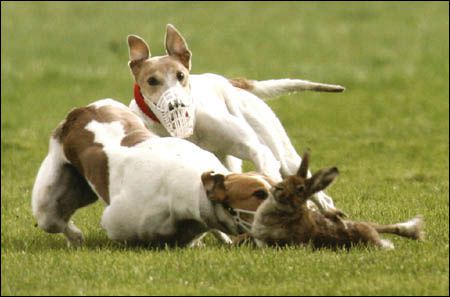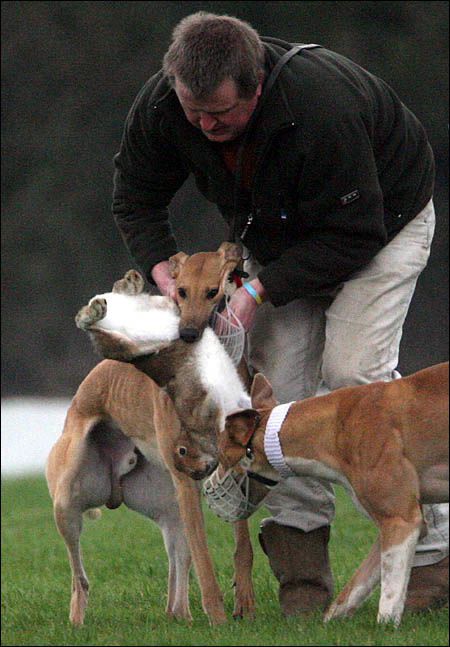Circular sent by the Campaign for the Abolition of Cruel Sports (CACS) to All members of Ireland's national parliament, the Dail, re the future of hare coursing in Ireland:
Campaign for the Abolition of Cruel Sports
Lower Coyne Street, Callan, Co. Kilkenny
Phone: (056) 7725543
October 26th 2010
Re: The future of the Irish Coursing Club and the cruel practice it endorses
Dear Deputy,
We draw your attention to an upcoming court case that could impact on the future of the Irish Coursing Club, the umbrella body for Ireland’s cruel hare-coursing clubs.
This case could wipe out the ICC’s finances, and the concern of CACS and other groups involved in promoting higher standards of animal welfare in Ireland is that the government might come under pressure from elements within the greyhound industry, and/or the influential pro-blood sports lobby, to lend financial assistance to the ICC.
The case of Greenband Investments v the Irish Coursing Club is due to be heard in the Commercial Court, Dublin, on Tuesday, January 18th 2011.
The background to the case is thus: Limerick-based property developers, Greenband Investments, are suing the Irish Coursing Club for 5.2 million euro plus interest, claiming that the ICC reneged on an agreement to sell a right of way on land adjoining its head office in Clonmel, County Tipperary. The property developer believed it had a binding contract with the ICC to sell a vital strip of land that it required for a planned 31m Euro retail development.
The ICC denied that it had agreed to sell the piece of land and Greenband then claimed that the ICC had revoked a legally binding contract.
Last year, Greenband won the first round of its court battle with the ICC. The judgement delivered by Justice Frank Clark can be read on the Irish legal website Courts.ie.
The next stage of the case will be for the Commercial Court to decide on the extent of the damages to be awarded against the ICC.
We are aware that the Irish Coursing Club is already in deep financial trouble and that a substantial damages award against it in January could topple it completely. Such an outcome would, we predict, enhance the status of Ireland’s persecuted hare population. It would be enormously beneficial to the endangered Irish Hare, under pressure from modern agricultural practises as well as from the activities of the coursing clubs affiliated to the ICC.
Aside from its role in overseeing the many public exhibitions of hare-coursing at venues nationwide, the ICC is the body that all greyhounds must be registered with before being eligible to enter in either coursing or track racing events. Its main source of income is the money raised from registration fees.
The ICC has long been a negative and debilitating influence within the greyhound industry, tainting the image of the entire industry with its support for a cruel blood sport that is, according to professional opinion polls, loathed by the vast majority of the Irish people.
While not commenting in any way on the legal rights or wrongs of the case before the Commercial Court concerning the ICC and Greenband, we are concerned at the possibility that if the organisation is effectively toppled as a result of the court case, the pro-blood sport lobby and diehard coursing elements within the greyhound industry will press for State funding or some kind of financial bail-out.
We implore all TDs and Senators not to countenance any financial assistance whatsoever to the ICC, unless and until it commits itself to replacing the use of live hares with the humane alternative of drag coursing.
We believe that this is a reasonable condition to impose on the organisation, as coursing clubs in other countries, including Britain and Australia, successfully diverted to the drag version after live coursing was banned by their parliaments.
We ask you not to capitulate to pressure from any source aimed at salvaging the ICC in the event of its financial demise unless it explicitly renounces the use of live hares in coursing and gives a clear commitment that all affiliated coursing clubs will switch to drag coursing within a specified time period.
Following are three pieces of footage that you might care to have a look at in this context. We maintain that the introduction of drag coursing to Ireland to replace the horrific cruelty to hares that currently passes for “sport” will benefit both the hares and the greyhound industry itself.
1. A brief film of live hare coursing as practiced today in Ireland with muzzled greyhounds: http://www.youtube.com/watch?v=D58qbzC-GI4
2. Photographic evidence of cruelty in hare coursing. All pictures taken at muzzled hare coursing events in Ireland: http://www.flickr.com/photos/icabs/sets/72157624180875760/
3. A brief film promoting drag coursing: It proves that this humane alternative replicates all the fun and excitement of coursing- without the cruelty: http://www.youtube.com/view_play_list?p=429C65F8B84B0783
Thanking you for your kind attention,
Sincerely,
John Fitzgerald,
PRO,
Campaign for the Abolition
Of Cruel Sports
Article on commenmcement of new hare coursing season:
The hare coursing season commences on September 26th. Thousands of hares will be rounded up by gangs of men and boys and snatched from their peaceful homes in the countryside. Following a period of “training”, the helpless and terrified captives will then be forced to run from pairs of greyhounds. Some will die, either from being struck forcibly by the larger and faster dogs, or from stress-related ailments arising from their unnatural captivity or the chase itself. We have no way of know what becomes of the hares released after being coursed, though we do know that hares subjected to high stress levels may die within days of the experience.
What makes the upcoming season all the more objectionable is the fact that information elicited under FOI has revealed a litany of breaches of the legally binding conditions attached to the license under which hares are netted for this “sport”. Technically, the Minister for the Environment has the power to revoke or amend the netting license if he is presented with evidence of widespread violations of the license conditions in the previous coursing season.
License breaches found to have occurred in the 2009-2010 season include the netting of hares by coursing clubs without the permission of the landowners, the removal of sick hares from the wild for coursing, failure to release hares by the specified time after coursing events, and failure by clubs to return coursed hares to their original habitats.
One club is revealed to have detained its consignment of captured hares for six weeks after its coursing event to use at another fixture. Hares were re-coursed at a number of venues, another breach of the netting license.
We would contend that these violations add up to a very strong case for revoking the hare netting license this year. Apart from these blatant examples of coursing clubs ignoring or flouting the pathetic set of rules designed to make hare coursing less inhumane, there is a conservationist argument against allowing another baiting season: The National Parks and Wildlife Service admits on its website that the Irish Hare is a species under threat.
In its official submission to the Convention on Biological Diversity last May, the NPWS declared that the Irish Hare is "experiencing pressure from loss of suitable habitat and consequently its status is considered poor".
Minister Gormley could greatly enhance the status of this beleaguered creature by calling a halt to hare coursing. It is a relic of the dark ages and the damning spectre of cruelty hangs over it.
Thanking you,
Yours sincerely,
John Fitzgerald
(Campaign for the Abolition
Of Cruel Sports)





